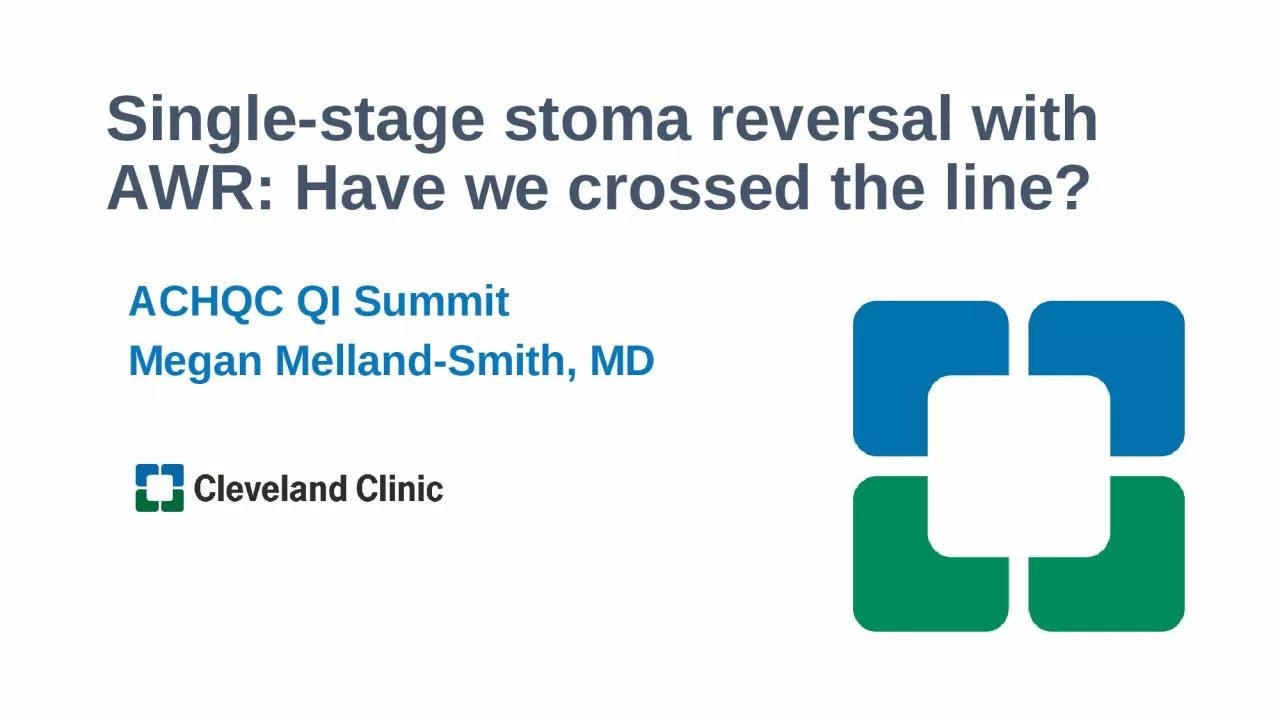

ACHQC QI Summit Megan MellandSmith MD Disclosures Study Funding none Clayton Petro BD Consultant Surgimatix Consultant Research Grants AHS CSA SAGES Ajita Prabhu Speaking fees and research support paid to institution from Intuitive Surgical ID: 1039198
Download Presentation The PPT/PDF document "Single-stage stoma reversal with AWR: Ha..." is the property of its rightful owner. Permission is granted to download and print the materials on this web site for personal, non-commercial use only, and to display it on your personal computer provided you do not modify the materials and that you retain all copyright notices contained in the materials. By downloading content from our website, you accept the terms of this agreement.
1. Single-stage stoma reversal with AWR: Have we crossed the line?ACHQC QI SummitMegan Melland-Smith, MD
2. DisclosuresStudy Funding: noneClayton PetroBD ConsultantSurgimatix ConsultantResearch Grants - AHS, CSA, SAGESAjita PrabhuSpeaking fees and research support paid to institution from Intuitive SurgicalConsulting fees and is on the Advisory Board for CMR SurgicalConsulting fees from Verb SurgicalLucas BeffaHonoraria from Intuitive SurgicalMichael RosenMedical director of ACHQCStock options with Ariste
3. Temporary Stomas & Hernias
4. Stoma ClosureCommon referral from Colorectal surgery Opportunity to consolidate surgeriesRisk vs benefitPrimary suture repair of ostomy site: 20-40% incisional hernias (Bhanghu et al. 2012)To stage or not to stage?
5. Fight or FlightPetro and Rosen, 2018
6. Staged approachProhibitive level of contaminationRisk of re-operation - i.e. anastomotic leakNeed for diverting loop ileostomySurgeon comfortTime for flightWhat’s going to be different next time?
7. Let’s Fight!Single stage approachGI part of the case = PerfectOptimized patient with adequate nutrition**Obese, diabetic smoker with high output stoma** Can tolerate another several hours of anesthesia
8. Mesh in Contaminated FieldsBiologic vs synthetic:SSOPI - 27.6% vs 24.6% SSI - 21.3% vs 15.1%SSO - 7.1% vs 11.1%1 biologic mesh excision 2 yr recurrence rate: 20.5% vs 5.6%Short-term infectious complications do not translate into long term recurrence with synthetic meshPhasix??
9. Single-stage stoma reversal with AWR: Have we crossed the line? An ACHQC AnalysisMelland-Smith et al.
10. Patient Characteristics368 patientsPermanent synthetic (PS) vs Biologic vs Resorbable synthetic (RS)Retromuscular mesh89 ileostomies, 276 colostomies, 3 bothVariablePermanent syntheticn= 279Biologicn= 46Resorbable syntheticn= 43p-valueAge, y, median (IQR)62 (51-69)59 (49-70)59 (53-68)0.7BMI, kg/m2, median (IQR)30.3 (26.2-35.4)29.0 (25.2-31.9)30.8 (27.6-32.9)0.1Diabetes mellitus, n (%)57 (20.4)9 (19.2)8 (18.6)0.9Smoking, n (%)50 (18.1)10 (21.7)10 (23.3)0.6Immunosuppressants17 (6.1)3 (6.5)5 (11.6)0.4Hx of abdominal wall infection69 (24.7)13 (28.3)18 (41.9)0.06Mesh location, n (%) Retromuscular/preperitoneal279 (100.0)46 (100.0)43 (100.0)NARecurrent hernia, n (%)50 (17.9)8 (17.4)8 (18.6)0.9Type of hernia, n (%) Incisional214 (76.7)38 (82.6)33 (76.7)0.6 Parastomal 210 (75.3)27 (58.7)22 (51.2)0.01
11. Hernia CharacteristicsVariablePermanent syntheticn = 279Biologicn = 46Resorbable syntheticn = 43p-valueBowel preparation171 (61.3)23 (50.0)22 (51.2)0.9Hernia width cm, median (IQR)11.0 (6.0-15.0)12.5 (8.0-16.1)10.0 (6.0-12.1)0.2Mesh width cm, median (IQR)23.0 (16.7-30.0)22.0 (18.9-30.0)20.0 (12.4-25.0)0.02Myofascial release, n (%)261 (93.6)40 (87.0)38 (88.4)0.2 External oblique4 (1.5)2 (5.0)4 (10.5)0.01* Transversus abdominus 186 (71.3)29 (72.5)25 (65.8)0.6Fascial closure, n (%)271 (97.1)45 (97.8)42 (97.7)0.9Operative time >240 min, n (%)193 (69.2)32 (69.6)27 (62.8)0.5Approach 0.2 Laparoscopic0 (0)1 (2.2)1 (2.3)- Open278 (99.6)45 (97.8)42 (97.7)- Robotic1 (0.4)00 (0)-Avg hernia width 11.2cm>65% TARs>97% fascial closure >97% open repairs
12. 30-day Outcomes##No differences between mesh types3 PS mesh infections1 PS mesh excision4 PS enterocutaneous fistulasOnly 1 mesh infection AND EC fistula??? Anastomotic leakMesh type PS (n= 242)Biologic (n= 42)RS (n= 38)p-valueSSI, n (%)32 (13.2)6 (14.3)5 (13.2)0.9 Superficial12 (37.5)4 (66.7)3 (60.0)0.3 Deep13 (40.6)2 (33.3)2 (13.2)0.9 Organ space11 (34.4)0 (0)1 (20.0)0.2SSO, n (%)43 (17.8)5 (11.9)4 (10.5)0.4SSOPI, n (%)34 (14.1)6 (14.3)3 (7.9)0.6Length of stay, d, median (IQR)5 (4-7)7 (4-9)7 (5-10)0.04*Reoperation, n (%)9 (3.7)2 (4.8)2 (5.3)0.9Readmission, n (%)25 (10.3)6 (14.3)6 (15.8)0.5
13. 1-Year OutcomesMesh type/location (number of patients with 1-yr follow-up)Recurrence 1 year, n (%)HerQLes baseline, Median (IQR)HerQLes 1 year, Median (IQR)PS (n=98)6 (6.1)41.7 (20.0-69.4)83.3 (59.6-95.1)Biologic (n=31)1 (3.2)8.3 (6.1-39.4)95.0 (80.3-100.0)RS (n=13)1 (7.7)47.5 (23.3-87.8)66.7 (51.4-95.8)p-valueP=0.56P=0.05P=0.3* 5 of 8 were colostomies* BMI 30, hernia width 10.8 cm* 3 parastomal hernias, 2 incisional hernias, 3 both35% f/u74% f/u34% f/u
14. DiscussionNo significant differences in wound morbidity between mesh typesOnly PS mesh infection, excision, EC fistulaRisk of anastomotic leak cannot be underestimatedDanish Hernia Database 2021 – 5.4% leak rateObliterated retromuscular plane Complicates future AWROma et al. 2021, Hernia
15. Bailout optionsPrimary closure – interrupted figure-of-eight PDS suturesInlay or bridging piece of Vicryl® mesh or biologic – expensive hernia sac *Both have inevitably high recurrence ratesAre there other options? Fascial release of tension – posterior rectus sheath
16. Key TakeawaysRemember, next time it’s a CLEAN caseType of mesh doesn’t really matter…choosing the correct patient matters moreConsent for both!Mesh is safe in contaminated fields…most of the timeStaged vs single stage prospective study is needed
17. Thank you!Megan Melland-Smithmellanm@ccf.org
18.
19. Rough work##
20. ACHQC vs Danish Hernia Database368 patients; 1yr f/u89 ileostomies, 276 colostomies, 3 both >50% had parastomal and incisional hernia11cm hernia width100% repaired with retromuscular permanent synthetic vs biologic vs resorbable synthetic mesh516 patients; 6yr f/uIncisional hernia repair vs concurrent stoma closure 64 ileostomies, 65 colostomies9cm hernia width75% repaired with mesh**ACHQCDanish Hernia Database
21. Outcomes##All mesh types:SSOPI 12%SSI 13%SSO 13%3 PS mesh infections, 1 mesh excision4 enterocutaneous fistulasIncreased re-operation for recurrence (17.8% vs 10.6%, OR 1.69, p=0.04)Subgroup analysis of mesh patients OR 1.54, p=0.125.4% anastomotic leakIncreased LOS (8 vs 3 days)ACHQCDanish Hernia Database
22. ConclusionNo significant differences in wound morbidity between mesh typesOnly PS mesh infection, excision, EC fistulaSingle stage approach is feasibleBailout is ok too Primary closure – interrupted figure-of-eight PDS suturesInlay or bridging piece of Vicryl® mesh Next time it’s a clean case!